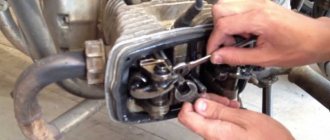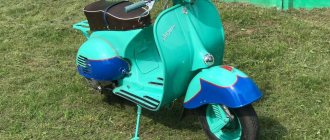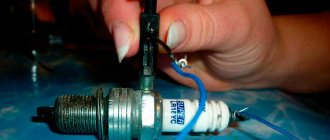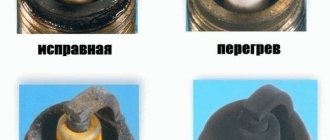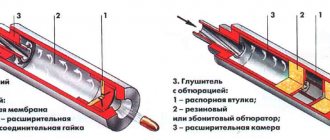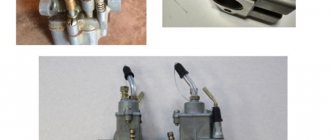Home » New products » Motor vehicle recorders: is it worth buying such electronics, and if so, what models
my_user 06/15/2021 619
1
SavingSavedRemoved 0
It is believed that motorcyclists communicate with whistle and baton workers many times less often than motorists, because not every biker can be caught by the police. However, not only joy happens on the roads - “interviews” with traffic police officers, and accidents (for which the police and even pedestrians immediately prefer to blame a respectable motorcyclist). A motorcycle video recorder helps you prove that you are right in a sticky situation... And preserve “for posterity” the beauty of the road you once rode along.
How to choose
Criteria for choosing a recorder for a motorcycle:
- The device must be compact and lightweight.
- Such a device must be protected against shocks and falls.
- The camera should shoot video at a 360° angle.
- There must be a reliable mount on the motorcyclist's helmet or handlebars.
Mounting the DVR
Before you buy a DVR, you first need to decide where it will be installed. When choosing a location for installing the main unit, you should take into account the length of the wires. In addition, you need to understand where to install the device’s sensors. The standard package always includes a microphone, display unit, antenna and 2 cameras.
It is more difficult to decide where to install cameras on a motorcycle. For example, you can mount it behind a windshield, but when shooting the video image will be distorted. The optimal place for the camera is considered to be the area under the headlight. But you need to place the recorder so that the front fender of the bike does not touch the device. The rear camera is best mounted in the area under the trunk. This way it will be protected from external influences and sun glare. It is best to secure all wires coming from the device modules with plastic clamps.
An alternative way is to install a video recorder on a helmet. This placement of the camera allows it to capture everything the motorcyclist sees, not just the space in front of the vehicle. This method of mounting the camera is preferred by athletes and extreme sports enthusiasts.
Best models
Among the best models of car recorders for motorcycles are:
- KY MT-18;
- Mio MiVue C330;
- Mio MiVue C325;
- Biker AIR;
- AVS0710DVR.
KY MT-18 is a small motorcycle data recorder. A photosensitive CMOS matrix is installed here. The device can record videos in high resolution Full HD. All captured files are recorded in AVI format. The user can adjust the duration of loop recording. To store files, a microSD memory card is used, which must be purchased separately. There is a powerful 200 mAh battery installed here.
Technical characteristics and indicators of the model:
| Video resolution | 1280*720 |
| Display diagonal | 3 inches |
| Screen aspect ratio | 16:9 |
| Maximum frame rate per second | 30 |
| Camera | 1.3 MP |
| Lens viewing angle | 150° |
| Total number of lenses | 2 |
| Minimum video length | 2 minutes |
| Longest video length | 10 minutes |
| Allowed memory card capacity | 32 GB |
| Average device cost | 3000 rub. |
Mio MiVue C330 is a compact device, the body of which is made of high-quality black plastic. This device has a camera equipped with glass lenses and a light-sensitive matrix, thanks to which the gadget can shoot high-quality video even in low light conditions. Thanks to the WDR function, you can improve the quality of the footage by removing all highlights. The user can activate the SmartAlert option, which will notify the driver if the permissible speed limit is exceeded.
Recorder technical parameters:
| Screen diagonal | 2 inches |
| Operating temperature | -10…+60°С |
| Dimensions | Width - 62 mm Height - 51 mm Depth - 37 mm |
| Full mass | 65 g |
| Memory card capacity | Up to 128 GB |
| Capture angle | 130° |
| Video codec | H.264 |
| Maximum video recording speed | 30 fps |
| Video resolution | 1920*1080 |
| Number of channels for audio recording | 1 |
| Price | 6000 rub. |
Mio MiVue C325 is a recorder equipped with a camera with a wide-angle lens. The following operating modes are available to the user:
- cyclic recording;
- continuous recording without wasting seconds or breaks;
- night mode;
- photography;
- automatic start and shutdown by timer.
The camera lenses are made of glass, which increases their service life. All elements are powered either through a built-in battery or through the motorcycle’s on-board network. For connection to a computer, the design provides a connector for a mini-USB cable.
Technical data of the model:
| Monitor diagonal | 2 inches |
| Video resolution | 1920*1080 |
| Recording speed at maximum settings | 30 fps |
| Camera angle | 130° |
| Memory card | Up to 128 GB |
| Working temperature | -10…+60°С |
| Dimensions | Width - 62 mm Height - 51 mm Thickness - 37 mm |
| Total weight | 65 g |
| Number of channels for audio recording | 1 |
| Voltage | 12 V |
| average cost | 5300 rub. |
Biker AIR is a recorder whose body is made of metal, which increases the service life of the device. One of the features of this gadget is the presence of an image stabilizer, thanks to which the picture is clear and with a high level of detail even when driving off-road. The display is equipped with IP56 waterproof coating. This model supports microSD memory cards, the volume of which should not exceed 128 GB.
Technical characteristics of the Biker AIR gadget:
| Video resolution | 1280*720 |
| Display diagonal | 3 inches |
| Screen aspect ratio | 16:9 |
| Maximum frame rate per second | 60 |
| Camera | 5 MP |
| Lens viewing angle | 150° |
| Total number of lenses | 2 |
| Minimum video length | 2 minutes |
| Longest video length | 10 minutes |
| Dimensions | 185*170*60 mm |
| Average device cost | 10900 rub. |
AVS0710DVR is a recorder that is used for video recording while a motorcycle is moving. The camera is equipped with an IP57 protective coating against moisture and dust and 2 glass lenses. Thanks to the built-in LED backlight, the device can shoot high-resolution video even in the dark. The G-sensor will help the driver not to lose footage during sudden braking or an emergency situation. This device has a motion indicator that starts recording when moving objects enter the camera's view.
Technical data of AVS0710DVR:
| Screen diagonal | 2 inches |
| Operating temperature | -10…+60°С |
| Dimensions | Width - 65 mm Height - 55 mm Depth - 32 mm |
| Full mass | 80 g |
| Memory card capacity | Up to 128 GB |
| Capture angle | 140° |
| Video codec | H.264 |
| Maximum video recording speed | 30 fps |
| Video resolution | 1920*1080 |
| Number of channels for audio recording | 1 |
| Price | 13500 rub. |
Remember this
- Be sure to clean your camera lens before each use. You need a clean lens, it's the most reliable way to take clear images and videos. When you drive off-road, check it from time to time for dirt.
- If you mostly drive on rough terrain, it is recommended to replace the camera body with a more durable one. Of course, a waterproof case will also protect your device from adverse weather conditions. However, it will not help protect the camera from accidents or severe falls, especially at high speeds.
- Shooting in 4K resolution will offer you the highest possible resolution. While this is good, in most cases it is not necessary. You will surely get amazing videos, but the quality depends on your battery and storage space. Consider shooting at a lower resolution, such as 1080p, as it will give you high-quality footage and improve battery life. In addition, data takes up less space on the SD card.
- If you record a lot, you'll get more value with less hassle by purchasing a larger SD card. These little accessories are inexpensive, so don't skimp on bringing as many as you need for your shoot.
Headsets for motorcycle helmets
After purchasing a helmet, you can install the headset yourself. It will not be difficult to choose a device for an open protective device (with a rigid microphone mounting rod), as well as for fully closed helmets (with a flexible wire and a convenient fixation system at mouth level). That is, the choice of helmet headsets is very diverse both in price and in functionality and configuration.
Installing the device is quite simple:
- Remove the inner lining.
- We attach the speakers at ear level using double-sided tape.
- Using the included accessories, install the microphone.
- We attach the Bluetooth device to the outside of the helmet in the most convenient place for use (usually using a clip to the bottom edge of the case).
- We connect the connecting cable.
- We install the inner lining in place.
The most famous and deservedly popular manufacturers of such devices are the British “Midland”, the Italian “Cellularline” and the American “Cardo” and “Sena”.
The “Bluetooth Interphone Tour” model from “Cellularline” complete with two microphones (for various modifications of helmets) and ultra-thin headphones now costs 18,000–19,000 rubles. The conference mode provides communication with 4 motorcycles simultaneously (range up to 1.5 km). A full battery charge lasts for 20 hours of continuous talk (more than enough even for a very long trip). The device is compatible with most modern smartphones based on iOS or Android, and GPS navigators.
Devices of a similar purpose with more modest technical characteristics from Chinese, Fodsports, Lexin or VnetPhone are much cheaper.
The universal model “BT-S2” from “Fodsports” with one microphone can be purchased for only 3000–3500 rubles. Two-way communication can be carried out only in 2 modes: motorcyclist-passenger or with two other motorcyclists at a distance of up to 0.5÷1 km. Continuous active operation time up to 8 hours (standby time – 300 hours).
Motorcycle helmet with built-in headset
Today on the market of protective devices you can find helmets with an installed headset for the two most popular modifications: “Full Face” and “Modular”.
The transformable model “H-6618 Blinc Bluetooth” (from the American “Hawk”), compatible with almost any mobile phone, iPhone and GPS navigation device, now costs 20,000–21,000 rubles. The battery ensures the device operates for 4 hours of continuous talk time and more than 100 hours of standby time.
For approximately the same price, you can purchase a monolithic Commander Bluetooth from O'Neal (talk time - 6 hours, standby time - 130 hours).
Chinese models offer models in a more affordable price range. Her closed helmet “V170B-Bluetooth” now costs about 9000–9500 rubles.
Products in this category of motorcycle accessories are also offered by the American “Torc”, the Korean “HJC” and even the legendary German “Schuberth”.
The main advantages of motorcycle helmets with a built-in Bluetooth headset:
- The communicator is fully integrated into the helmet body, does not protrude outward and does not interfere with aerodynamic properties.
- All components of the kit are optimally located and firmly secured.
Flaws:
- When replacing a helmet, the Bluetooth kit cannot be transferred to a new product.
- Difficulties with maintenance and repair if necessary.
This is interesting: Which car brands are restoring sales in Russia
Many helmet companies produce products that come with factory-installed headphones, a microphone, and an antenna. The owner only needs to purchase the communicator itself. The main advantages of such helmets are: the ability to select a Bluetooth device (with the necessary set of functions) and the ease of installation. A significant drawback is that only certain (recommended by the manufacturer) communicators can be installed in the recess in the helmet.
The Korean model of the fully closed helmet “CL-MAXBT II Bluetooth Ready” costs about 9,500 rubles.
Methods for installing a headset in a motorcycle helmet
It is impossible to answer a phone call while riding a motorcycle unless your helmet is equipped with a headset. Wired hands-free devices are becoming a thing of the past, but Bluetooth devices are becoming more and more popular as additional equipment for helmets. Today, there are three options that allow you to use a mobile phone while driving, listen to music, voice prompts from the navigator, and even communicate with a passenger or colleagues “on the shop floor” in conference mode (albeit at a very limited distance):
- purchase a helmet with a built-in headset;
- buy a product that is fully prepared (headphones, microphone and antenna are already installed at the time of manufacture) for installation of the communicator;
- Install the headset into a motorcycle helmet yourself.
Each option has its pros and cons.

